Розбір
Let's use the disjoint-set data structure. Initially, each vertex will be placed in a separate set. We will iterate through the edges in decreasing order of their weights. For each edge , we will run the function. It will merge the sets containing vertices and .
Consider the current edge of the tree with weight . Let it merge the sets with sizes and . All edges in these two sets have weights greater than or equal to . The edge is part of different paths. Since the weight is minimal, the distances of these paths are equal to . Therefore, the contribution of these paths to the sum of distances of all pairs of vertices is .
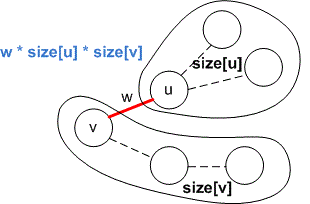
Example
Consider the first test.
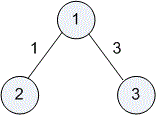
The graph contains three paths:
(distance );
(distance );
(distance );
The sum of distances between all pairs of vertices is equal to .
Consider the second test.
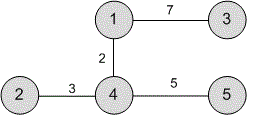
Assign each vertex to a separate set.

Iterate through the edges in descending order of weight. The first edge will be . Perform . The distance has path (from to ).
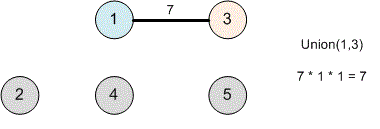
The next edge will be . Perform . The distance has path (from to ).
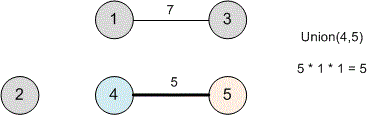
The next edge will be . Perform . The distance have paths (from to and from to ).
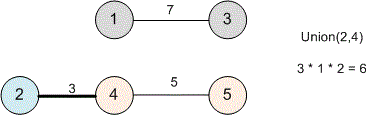
The next edge will be . Perform . The distance have paths .
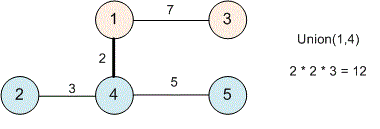
The desired sum of distances is equal to .
Algorithm realization
Declare arrays used by the disjoint-set system.
struct Edge
{
int u, v, cost;
} temp;
vector<Edge> e;
vector<int> parent, ssize;The cmpGreater function is a comparator that sorts the edges in descending order of weight.
int cmpGreater(Edge a, Edge b)
{
return a.cost > b.cost;
}The Repr function returns the representative of the set containing the vertex .
int Repr(int v)
{
if (v == parent[v]) return v;
return parent[v] = Repr(parent[v]);
}The Union function merges sets with elements and . Implement the heuristic with set sizes.
void Union(int x, int y)
{
x = Repr(x); y = Repr(y);
if (x == y) return;
if (ssize[x] < ssize[y]) swap(x, y);
parent[y] = x;
ssize[x] += ssize[y];
}The main part of the program. Read the number of vertices in the graph.
scanf("%d", &n);Initialize the arrays.
parent.resize(n + 1);
ssize.resize(n + 1);
for (i = 0; i <= n; i++)
{
parent[i] = i;
ssize[i] = 1;
}Read the edges of the tree. Store them in the array .
for (i = 0; i < n - 1; i++)
{
scanf("%d %d %d", &temp.u, &temp.v, &temp.cost);
e.push_back(temp);
}Sort the edges in descending order of weights.
sort(e.begin(), e.end(), cmpGreater);
Compute the sum of distances between all pairs of vertices in the variable .
res = 0;
Iterate through the edges. For each edge with weight call the function. Add the contribution of all paths with distance to .
for (i = 0; i < e.size(); i++)
{
res += 1LL * e[i].cost * ssize[Repr(e[i].u)] * ssize[Repr(e[i].v)];
Union(e[i].u, e[i].v);
}Print the answer.
printf("%lld\n", res);Python realization
Declare a class , describing an edge of the graph.
class Edge:
def __init__(self, u, v, cost):
self.u = u
self.v = v
self.cost = costThe cmpGreater function is a comparator that sorts the edges in descending order of weight.
def cmpGreater(a, b):
return a.cost > b.costThe Repr function returns the representative of the set containing the vertex .
def Repr(v): if v == parent[v]: return v parent[v] = Repr(parent[v]) return parent[v]
The Union function merges sets with elements and . Implement the heuristic with set sizes.
def Union(x, y):
x = Repr(x)
y = Repr(y)
if x == y: return
if ssize[x] < ssize[y]:
x, y = y, x
parent[y] = x
ssize[x] += ssize[y]The main part of the program. Read the number of vertices in the graph.
n = int(input().strip())
Initialize the lists.
parent = list(range(n + 1)) ssize = [1] * (n + 1) e = []
Read the edges of the tree. Store them in the list .
for _ in range(n - 1): u, v, cost = map(int, input().split()) e.append(Edge(u, v, cost))
Sort the edges in descending order of weights.
e.sort(key=lambda x: x.cost, reverse=True)
Compute the sum of distances between all pairs of vertices in the variable .
res = 0
Iterate through the edges. For each edge with weight call the function. Add the contribution of all paths with distance to .
for edge in e: res += edge.cost * ssize[Repr(edge.u)] * ssize[Repr(edge.v)] Union(edge.u, edge.v)
Print the answer.
print(res)